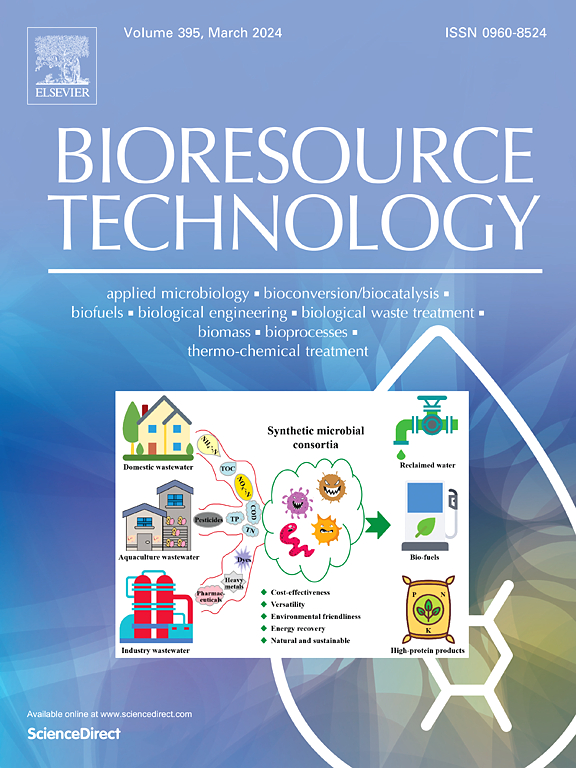利用改造的绿假单胞菌将玉米秸秆水解产物高效转化为苯那嗪-1-羧酸,用于可持续的生物农药生产。
IF 9
1区 环境科学与生态学
Q1 AGRICULTURAL ENGINEERING
引用次数: 0
摘要
木质纤维素转化为增值化学品为替代石化资源、减少环境影响和促进向绿色生产过渡提供了一个有前途的解决方案。木质纤维素生物质的水解产物富含葡萄糖、木糖和阿拉伯糖,通过各种生物技术过程有效转化这些糖对于最大限度地发挥木质纤维素生物质作为可再生资源的经济和环境效益至关重要。在这项工作中,我们设计了一株绿绿假单胞菌,它能有效地从玉米秸秆水解物中生产phenazine-1-羧酸(PCA),这是一种生物农药,在中国注册为“Shenqinmycin”。P. putida (iJN1462)的基因组尺度代谢模型通过纳入两个额外的途径适用于P. chlororaphis GP72。利用该模型,我们设计了一种菌株P. chloriraphis GP72,它能完全消耗玉米秸秆水解液中的所有糖并将其转化为PCA,产量为384.2 mg/L。这是首次报道充分利用玉米秸秆水解物中的糖来生产PCA。本研究证明了绿单胞菌利用玉米秸秆水解液进行PCA生物合成的潜力,并为利用假单胞菌合成木质纤维素生物质中的其他增值化学物质提供了有价值的参考。本文章由计算机程序翻译,如有差异,请以英文原文为准。

Efficient bioconversion of corn stover hydrolysates into phenazine-1-carboxylic acid by engineered Pseudomonas chlororaphis for sustainable biopesticide production
The conversion of lignocellulose into value-added chemicals provides a promising solution for replacing petrochemical resources, reducing environmental impact, and promoting the transition to green production. The hydrolysis products of lignocellulosic biomass are abundant in glucose, xylose, and arabinose, and the efficient conversion of these sugars through various biotechnological processes is crucial for maximizing the economic and environmental benefits of lignocellulosic biomass as a renewable resource. In this work, we engineered a strain of Pseudomonas chlororaphis that efficiently produces phenazine-1-carboxylic acid (PCA), a biopesticide registered in China as ’Shenqinmycin’, from corn stover hydrolysates. The genome-scale metabolic model of P. putida (iJN1462) was adapted for P. chlororaphis GP72 by incorporating two additional pathways. Using this adapted model, we engineered the strain P. chloriraphis GP72, which completely consumed all the sugars in corn stover hydrolysate and converted them into PCA, with a yield of 384.2 mg/L. This is the first report to display the full utilization of sugars in corn stover hydrolysate for PCA production. This work demonstrates the potential of P. chlororaphis in utilizing corn stover hydrolysate for PCA biosynthesis and provides valuable references for the biosynthesis of other value-added chemicals in lignocellulosic biomass using Pseudomonas.
求助全文
通过发布文献求助,成功后即可免费获取论文全文。
去求助
来源期刊

Bioresource Technology
工程技术-能源与燃料
CiteScore
20.80
自引率
19.30%
发文量
2013
审稿时长
12 days
期刊介绍:
Bioresource Technology publishes original articles, review articles, case studies, and short communications covering the fundamentals, applications, and management of bioresource technology. The journal seeks to advance and disseminate knowledge across various areas related to biomass, biological waste treatment, bioenergy, biotransformations, bioresource systems analysis, and associated conversion or production technologies.
Topics include:
• Biofuels: liquid and gaseous biofuels production, modeling and economics
• Bioprocesses and bioproducts: biocatalysis and fermentations
• Biomass and feedstocks utilization: bioconversion of agro-industrial residues
• Environmental protection: biological waste treatment
• Thermochemical conversion of biomass: combustion, pyrolysis, gasification, catalysis.
 求助内容:
求助内容: 应助结果提醒方式:
应助结果提醒方式:


